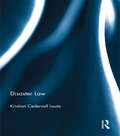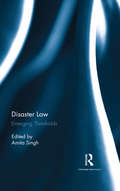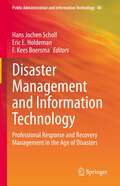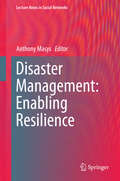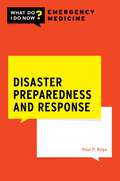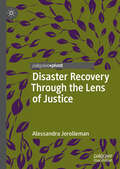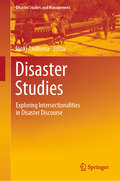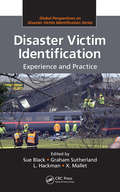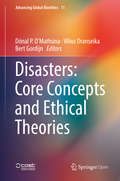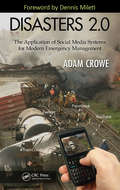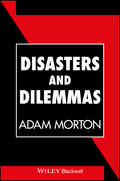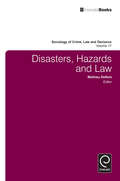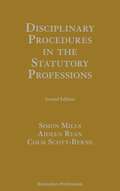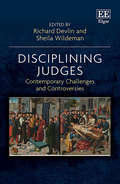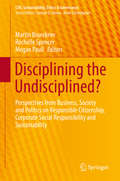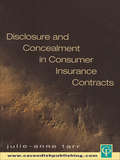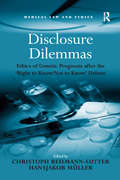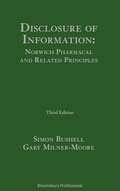- Table View
- List View
Disaster Law
by Kristian Cedervall LautaDisasters and their management are today central to public and political agendas. Rather than being understood as exclusively acts of God and Nature, natural disasters are increasingly analysed as social vulnerability exposed by natural hazards. A disaster following an earthquake is no longer seen as caused exclusively by tremors, but by poor building standards, ineffective response systems, or miscommunications. This book argues that the shift in how a disaster is spoken of and managed affects fundamental notions of duty, responsibility and justice. The book considers the role of law in disasters and in particular the regulation of disaster response and the allocation of responsibility in the aftermath of disasters. It argues that traditionally law has approached emergencies, including natural disasters, from a dichotomy of normalcy and emergency. In the state of emergency, norms were replaced by exceptions; democracy by dictatorship; and rights by necessity. However, as the disaster becomes socialized the idea of a clear distinction between normalcy and emergency crumbles. Looking at international and domestic legislation from a range of jurisdictions the book shows how natural disasters are increasingly normalized and increasingly objects of legal regulation and interpretation. The book will be of great use and interest to scholars and researchers of legal theory, and natural hazards and disasters.
Disaster Law
by Kristian Cedervall LautaDisasters and their management are today central to public and political agendas. Rather than being understood as exclusively acts of God and Nature, natural disasters are increasingly analysed as social vulnerability exposed by natural hazards. A disaster following an earthquake is no longer seen as caused exclusively by tremors, but by poor building standards, ineffective response systems, or miscommunications. This book argues that the shift in how a disaster is spoken of and managed affects fundamental notions of duty, responsibility and justice. The book considers the role of law in disasters and in particular the regulation of disaster response and the allocation of responsibility in the aftermath of disasters. It argues that traditionally law has approached emergencies, including natural disasters, from a dichotomy of normalcy and emergency. In the state of emergency, norms were replaced by exceptions; democracy by dictatorship; and rights by necessity. However, as the disaster becomes socialized the idea of a clear distinction between normalcy and emergency crumbles. Looking at international and domestic legislation from a range of jurisdictions the book shows how natural disasters are increasingly normalized and increasingly objects of legal regulation and interpretation. The book will be of great use and interest to scholars and researchers of legal theory, and natural hazards and disasters.
Disaster Law: Emerging Thresholds
by Amita SinghThis book looks at how legal frameworks can and do reduce risks arising out of disasters. The volume: analyses existing disaster laws and the challenges on the ground; brings together case studies from some of the most vulnerable regions; and proposes solutions to avert existing and possible future crises. The book offers appropriate legal frameworks for disaster management which could not only offer sustainable institutional reforms towards community resilience and preparedness but also reduce risk within the frameworks of justice, equity and accountability. It examines the intricacies of governance within which governments function and discusses how recent trends in infrastructure development and engineering technology could be balanced within the legal principles of ethics, transparency and integrity. The chapters in the volume suggest that legal frameworks ought to resonate with new challenges of resource management and climate change. Further, these frameworks could help secure citizens’ trust, institutional accountability and effective implementation through an unceasing partnership which keeps the community better prepared and more resilient. This volume will be indispensable to scholars and researchers of disaster management, law, public policy, environment and development studies as well as policymakers and those in administrative, governmental, judicial and development sectors.
Disaster Law: Emerging Thresholds
by Amita SinghThis book looks at how legal frameworks can and do reduce risks arising out of disasters. The volume: analyses existing disaster laws and the challenges on the ground; brings together case studies from some of the most vulnerable regions; and proposes solutions to avert existing and possible future crises. The book offers appropriate legal frameworks for disaster management which could not only offer sustainable institutional reforms towards community resilience and preparedness but also reduce risk within the frameworks of justice, equity and accountability. It examines the intricacies of governance within which governments function and discusses how recent trends in infrastructure development and engineering technology could be balanced within the legal principles of ethics, transparency and integrity. The chapters in the volume suggest that legal frameworks ought to resonate with new challenges of resource management and climate change. Further, these frameworks could help secure citizens’ trust, institutional accountability and effective implementation through an unceasing partnership which keeps the community better prepared and more resilient. This volume will be indispensable to scholars and researchers of disaster management, law, public policy, environment and development studies as well as policymakers and those in administrative, governmental, judicial and development sectors.
Disaster Management and Information Technology: Professional Response and Recovery Management in the Age of Disasters (Public Administration and Information Technology #40)
by Hans Jochen Scholl Eric E. Holdeman F. Kees BoersmaThis edited book entertains a multitude of perspectives on crisis information management systems (CIMS)-based disaster response and recovery management. The use of information technology in disaster management has become the central means for collecting, vetting, and distributing information. It also serves as the backbone for coordination and collaboration between response and recovery units as well as resource management tool. This edited volume aims at covering the whole range of application and uses of CIMS in disaster response and recovery. It showcases coordination and collaboration mechanisms between government agencies, the involvement of non-governmental entities, lessons learned as well as lessons not learned, approaches to disaster resiliency in society, community engagement in disaster/catastrophe responses and recovery, and, particularly, the role of CIMS in response and recovery. Serving as a platform for showcasing recent academic discoveries as well as a knowledge source for practitioners, this volume will be of interest to researchers and practitioners interested in disaster response, public administration, emergency management, and information systems.
Disaster Management: Enabling Resilience (Lecture Notes in Social Networks)
by Anthony MasysThe present work will discuss relevant theoretical frameworks and applications pertaining to enabling resilience within the risk, crisis and disaster management domain. The contributions to this book focus on resilience thinking along 4 broad themes: Urban Domain; Cyber Domain; Organizational/Social domain; and Socio-ecological domain. This book would serve as a valuable reference for courses on risk, crisis and disaster management, international development, social innovation and resilience. This will be of particular interest to those working in the risk, crisis and disaster management domain as it will provide valuable insights into enabling resilience. This book will be well positioned to inform disaster management professionals, policy makers and academics on strategies and perspectives regarding disaster resilience.
Disaster Preparedness and Response (WHAT DO I DO NOW EMERGENCY MEDICINE)
by Paul P. RegaDisaster medicine has occupied an increasingly important niche within the specialty of emergency medicine over the latter half of the 20th century. Regardless of whether an event was natural, anthropogenic, or a combination of both, emergency medicine was and is the ideal discipline to develop the human resources, the strategies, the tactics, and the evidence- based research to elevate the field of disaster medicine. It began, organizationally speaking, with Hurricane Hugo in 1989 and it is continuing through the 2019 COVID- 19 pandemic and beyond. Now that we are well into the 21st century, we must steady our footing as a specialty on the 20th century's foundation so that we can wrestle with the more intricate challenges of the future. In the past two decades our global populations have experienced sectarian violence, wars, genocide, migration, terrorism, emerging infectious diseases, and pandemics. These natural and anthropogenic events will only worsen exponentially as we become intrinsically trapped by the effects of climate change. The United Nation's Intergovernmental Panel on Climate Change has recently concluded that regardless of how we try to reverse the effects of global warming, what we are experiencing now in terms of hurricanes, floods, and droughts will continue to worsen over the next 30 years. Should we, as a species, continue to equivocate and as global temperatures climb, these events will become more frequent and more catastrophic. "Catastrophic" may even be too mild a term. It is possible that over the next few years, the academic arm of emergency medicine may need to consider developing a curriculum devoted to "Cataclysmic Medicine." To confront these possibilities, there first needs to be a knowledge of disaster medicine and disaster management at its most basic level. It begins with crisis leadership, command and control, communications, and coordination. When all these pieces of the jigsaw puzzle are fitted together properly and enclosed by a proper ethical frame, then the best and most ethical and moral disaster medical can will be provided to the patient and to the community. The intent of this book is to introduce these concepts using diverse viewpoints and scenarios. Readers are challenged to cogitate, create, and layer their own set of building blocks upon the preexisting foundation, thereby reinforcing and sustaining their own capacity to prepare for and respond to any adverse eventuality, mass casualty or otherwise. I hope that the experiential and evidence- based contents of this book will inspire readers to delve deeper into the nuances of disaster medicine and will serve as an impetus for a more profound quest for knowledge and a desire to serve those who will be experiencing the worst moments of their lives. The intent of this book is to introduce these concepts using diverse viewpoints and scenarios. Readers are challenged to cogitate, create, and layer their own set of building blocks upon the preexisting foundation, thereby reinforcing and sustaining their own capacity to prepare for and respond to any adverse eventuality, mass casualty or otherwise. It is hoped that the experiential and evidence- based contents of this book will inspire readers to delve deeper into the nuances of disaster medicine and it will serve as an impetus for a more profound quest for knowledge and a desire to serve those who will be experiencing the worst moments of their lives.
Disaster Preparedness and Response (WHAT DO I DO NOW EMERGENCY MEDICINE)
by Paul P. RegaDisaster medicine has occupied an increasingly important niche within the specialty of emergency medicine over the latter half of the 20th century. Regardless of whether an event was natural, anthropogenic, or a combination of both, emergency medicine was and is the ideal discipline to develop the human resources, the strategies, the tactics, and the evidence- based research to elevate the field of disaster medicine. It began, organizationally speaking, with Hurricane Hugo in 1989 and it is continuing through the 2019 COVID- 19 pandemic and beyond. Now that we are well into the 21st century, we must steady our footing as a specialty on the 20th century's foundation so that we can wrestle with the more intricate challenges of the future. In the past two decades our global populations have experienced sectarian violence, wars, genocide, migration, terrorism, emerging infectious diseases, and pandemics. These natural and anthropogenic events will only worsen exponentially as we become intrinsically trapped by the effects of climate change. The United Nation's Intergovernmental Panel on Climate Change has recently concluded that regardless of how we try to reverse the effects of global warming, what we are experiencing now in terms of hurricanes, floods, and droughts will continue to worsen over the next 30 years. Should we, as a species, continue to equivocate and as global temperatures climb, these events will become more frequent and more catastrophic. "Catastrophic" may even be too mild a term. It is possible that over the next few years, the academic arm of emergency medicine may need to consider developing a curriculum devoted to "Cataclysmic Medicine." To confront these possibilities, there first needs to be a knowledge of disaster medicine and disaster management at its most basic level. It begins with crisis leadership, command and control, communications, and coordination. When all these pieces of the jigsaw puzzle are fitted together properly and enclosed by a proper ethical frame, then the best and most ethical and moral disaster medical can will be provided to the patient and to the community. The intent of this book is to introduce these concepts using diverse viewpoints and scenarios. Readers are challenged to cogitate, create, and layer their own set of building blocks upon the preexisting foundation, thereby reinforcing and sustaining their own capacity to prepare for and respond to any adverse eventuality, mass casualty or otherwise. I hope that the experiential and evidence- based contents of this book will inspire readers to delve deeper into the nuances of disaster medicine and will serve as an impetus for a more profound quest for knowledge and a desire to serve those who will be experiencing the worst moments of their lives. The intent of this book is to introduce these concepts using diverse viewpoints and scenarios. Readers are challenged to cogitate, create, and layer their own set of building blocks upon the preexisting foundation, thereby reinforcing and sustaining their own capacity to prepare for and respond to any adverse eventuality, mass casualty or otherwise. It is hoped that the experiential and evidence- based contents of this book will inspire readers to delve deeper into the nuances of disaster medicine and it will serve as an impetus for a more profound quest for knowledge and a desire to serve those who will be experiencing the worst moments of their lives.
Disaster Recovery Through the Lens of Justice
by Alessandra JerollemanThere has been increased attention to the topics of disaster recovery and disaster resilience over the past several years, particularly as catastrophic events such as Hurricane Katrina and Superstorm Sandy have brought to light the increasing vulnerability of so many communities. This manuscript brings together existing research, along with policy analysis, in order to look at disaster recovery through the lens of justice. This includes understanding the mechanisms through which vulnerability is exacerbated, and the extent to which the regulations and agency cultures drive this outcome. While existing analyses have sought to understand the particular characteristics of both resilient and vulnerable communities, there have been few attempts to understand the systemic inequities and injustice that is built into United States disaster policies, programs, and legislation. This manuscript thus begins from the understanding that social and economic structures, including land use policies and historic practices such as redlining, have concentrated hazard risk into vulnerable zones whose inhabitants do not benefit from the very policies that create and increase their risk.
Disaster Studies: Exploring Intersectionalities in Disaster Discourse (Disaster Studies and Management)
by Janki AndhariaThis book covers several dimensions of disaster studies as an emerging discipline. It is the inaugural book in the series ‘Disaster Studies and Management’ and deals with questions such as “Is disaster management a field of practice, a profession, or simply a new area of study?” Exploring intersectionalities, the book also examines areas of research that could help enhance the discourse on disaster management from policy and practice perspectives, revisiting conventional event-centric approaches, which are the basis for most writings on the subject. Several case studies and comparative analyses reflect a critical reading of research and practice concerning disasters and their management. The book offers valuable insights into various subjects including the challenge of establishing inter- and multi-disciplinary teams within the academia involved in disaster studies, and sociological and anthropological readings of post-disaster memoryscapes. Each of the contributors has an enduring interest in disaster studies, thus enriching the book immensely. This book will be of interest to all the students and scholars of disaster studies and disaster management, as well as to practitioners and policymakers.
Disaster Victim Identification: Experience and Practice
by L. Hackman Sue Black G. Sunderland X. MallettDisaster management has become an increasingly global issue, and victim identification is receiving greater attention. By raising awareness through past events and experiences, practitioners and policymakers can learn what works, what doesn‘t work, and how to avoid future mistakes. Disaster Victim Identification: Experience and Practice presents a
Disasters: Core Concepts and Ethical Theories (Advancing Global Bioethics #11)
by Dónal P. O’Mathúna Vilius Dranseika Bert GordijnThis Open Access Book is the first to examine disasters from a multidisciplinary perspective. Justification of actions in the face of disasters requires recourse both to conceptual analysis and ethical traditions. Part 1 of the book contains chapters on how disasters are conceptualized in different academic disciplines relevant to disasters. Part 2 has chapters on how ethical issues that arise in relation to disasters can be addressed from a number of fundamental normative approaches in moral and political philosophy. This book sets the stage for more focused normative debates given that no one book can be completely comprehensive. Providing analysis of core concepts, and with real-world relevance, this book should be of interest to disaster scholars and researchers, those working in ethics and political philosophy, as well as policy makers, humanitarian actors and intergovernmental organizations..
Disasters 2.0: The Application of Social Media Systems for Modern Emergency Management
by Adam CroweEmerging social media and so-called Web 2.0 technologies will continue to have a great impact on the practice and application of the emergency management function in every public safety sector. Disasters 2.0: The Application of Social Media Systems for Modern Emergency Management prepares emergency managers and first responders to successfully appl
Disasters 2.0: The Application of Social Media Systems for Modern Emergency Management
by Adam CroweEmerging social media and so-called Web 2.0 technologies will continue to have a great impact on the practice and application of the emergency management function in every public safety sector. Disasters 2.0: The Application of Social Media Systems for Modern Emergency Management prepares emergency managers and first responders to successfully appl
Disasters and Dilemmas: Strategies for Real-Life Decision Making
by Adam MortonThe author presents a number of strategies for making decisions based on desires or values which are incompatible or which conflict with one another in various ways. Cases discussed include conflicts of first and second order desires, conflicts between desires for present and for future ends, problems deriving from anticipated changes of desire, risk-taking problems, and coordination problems. One central claim of the book is that the same dilemma-managing strategies can be applied to all of these. The book also argues that many of the characteristics of moral dilemmas appear in non-moral decision-making. The relations between these strategies and utility-maximizing decision rules are subtle, and are explored throughout the book. To some extent the strategies apply to cases which are too complicated for utility-maximization to apply. Some of them also apply to the early stages of decision-making where utility-maximization does not enter, for example, in selecting a list of options for serious consideration. In some tidy cases, though, the strategies give different recommendations. This book is meant to have both a theoretical and a practical appeal, deriving from our need for ways of making decisions that do not force us to find trade-offs between goods or values which are hard to compare. The strategies presented in the book are meant to be usable in situations which seem to force decision-makers to balance very different quantities, and the discussion of them is meant as a contribution to debates about incomparable values, moral dilemmas and rational decision.
Disasters and Dilemmas: Strategies for Real-Life Decision Making
by Adam MortonThe author presents a number of strategies for making decisions based on desires or values which are incompatible or which conflict with one another in various ways. Cases discussed include conflicts of first and second order desires, conflicts between desires for present and for future ends, problems deriving from anticipated changes of desire, risk-taking problems, and coordination problems. One central claim of the book is that the same dilemma-managing strategies can be applied to all of these. The book also argues that many of the characteristics of moral dilemmas appear in non-moral decision-making. The relations between these strategies and utility-maximizing decision rules are subtle, and are explored throughout the book. To some extent the strategies apply to cases which are too complicated for utility-maximization to apply. Some of them also apply to the early stages of decision-making where utility-maximization does not enter, for example, in selecting a list of options for serious consideration. In some tidy cases, though, the strategies give different recommendations. This book is meant to have both a theoretical and a practical appeal, deriving from our need for ways of making decisions that do not force us to find trade-offs between goods or values which are hard to compare. The strategies presented in the book are meant to be usable in situations which seem to force decision-makers to balance very different quantities, and the discussion of them is meant as a contribution to debates about incomparable values, moral dilemmas and rational decision.
Disasters, Hazards and Law (Sociology of Crime, Law and Deviance #17)
by Mathieu DeflemThis volume deals with important social-science issues of law and legal control pertaining to disasters and hazards in a variety of contexts. The orientation of this volume is driven by relevant recent occurrences, such as hurricanes Katrina and Irene in the United States; the 2010 BP oil spill, and the 2011 Japanese earthquake and tsunami. Thematically diverse within the province of the social and behavioral sciences related to law and law-related problems, the chapters in this volume are not restricted in terms of theoretical approach and methodological orientation. Topics addressed include: legal controls pertaining to disaster prevention, response, and mitigation; regulations and policies concerning hazardous conditions; and crime and the control thereof in post-disaster situations.
Disciplinary Procedures in the Statutory Professions
by Simon Mills Aideen Ryan Colm Scott-ByrneVarious disciplinary and regulatory bodies have different rules, powers and procedures, even while sharing a basic legal framework. This book allows a legal practitioner who is appearing before such a body to prepare their case by setting out what powers the body has, what evidence it can hear, the form the procedure will take, whether they can call witnesses, and what sanctions it can impose.This book is the first title to consider the specific question of the regulation of statutory professions in Ireland including architects, surveyors, teachers, pharmacists, health and social care professionals and accountants.Part I deals with general principles and practice, covering such areas as complaints, fair procedures and sanctions.Part II examines each of the relevant professions in turn.Covers the following developments, legislation and case law:The difference of between professional misconduct conduct and poor professional performanceTeaching Council (Amendment) Act 2015Healthcare (Miscellaneous Provisions) Bill 2017Regulated Professions (Health and Social Care) (Amendment) Act 2020Corbally v Medical Council & OthersMedical Council v Lohan-Mannion Doocey v Law Society TM v Medical Council
Disciplining Judges: Contemporary Challenges and Controversies
Globally, countries are faced with a complex act of statecraft: how to design and deploy a defensible complaints and discipline regime for judges. In this collection, contributors provide critical analyses of judicial complaints and discipline systems in thirteen diverse jurisdictions, revealing that an effective and legitimate regime requires the nuanced calibration of numerous public values including independence, accountability, impartiality, fairness, reasoned justification, transparency, representation, and efficiency. The jurisdictions examined are Australia, Canada, China, Croatia, England and Wales, India, Italy, Japan, the Netherlands, Nigeria, Poland, South Africa, and the United States. The core findings are four-fold. First, the norms and practices of each discipline regime differ in ways that reflect distinct social, political, and cultural contexts. Second, some jurisdictions are doing better than others in responding to challenges of designing a nuanced and normatively defensible regime. Third, no jurisdiction has yet managed to construct a regime that can be said to adequately promote public confidence. Finally, important lessons can be learned through analysis of, and critically constructive engagement with, other jurisdictions. The first comprehensive comparative collection on judicial discipline systems, Disciplining Judges, will inspire new conversations among academics, students, judges, governmental officials and political scientists.
Disciplining the Undisciplined?: Perspectives from Business, Society and Politics on Responsible Citizenship, Corporate Social Responsibility and Sustainability (CSR, Sustainability, Ethics & Governance)
by Martin Brueckner Rochelle Spencer Megan PaullThis book explores how the interrelated concepts of responsible citizenship, corporate social responsibility (CSR) and sustainability can be interpreted, researched and taught. It contributes to the much-needed debate on the role of universities – and business schools in particular – in the context of rising social and environmental stakes and growing calls for 'doing business the right way'. The book offers diverse perspectives on the concepts of responsible citizenship, CSR and sustainability, with individual contributions focusing on the conceptual implications for specific disciplines, exploring associated challenges and opportunities, and raising methodological and theoretical concerns for the teaching and research of these concepts laden with complexity and ambiguity. The book is divided into three major parts, the first of which presents conceptual, theoretical and ethical issues. In turn, part two explores specific disciplines' perspectives. Lastly, part three presents hands-on experiences from the field. Thanks to this threefold approach, the book not only offers a guide to direct future research, but can also be used as a text for advanced courses on responsible citizenship, CSR and sustainability.
Disclosure and Concealment in Consumer Insurance Contracts
by Julie-Ann TarrThis book provides an in-depth examination of the theoretical,legal, social and economic foundations to disclosure and concealment of information in relation to the formation of consumer insurance contracts. A comparative treatment of this issue is undertaken with particular attention given to the judicial and legislative approaches adopted in the United Kingdom, the United States of America, Australia and New Zealand. It will be relevant to those researching and studying insurance law, all legal practitioners involved with the formation of consumer insurance contracts and non-legal practitioners working within the field of insurance.
Disclosure and Concealment in Consumer Insurance Contracts
by Julie-Ann TarrThis book provides an in-depth examination of the theoretical,legal, social and economic foundations to disclosure and concealment of information in relation to the formation of consumer insurance contracts. A comparative treatment of this issue is undertaken with particular attention given to the judicial and legislative approaches adopted in the United Kingdom, the United States of America, Australia and New Zealand. It will be relevant to those researching and studying insurance law, all legal practitioners involved with the formation of consumer insurance contracts and non-legal practitioners working within the field of insurance.
Disclosure Dilemmas: Ethics of Genetic Prognosis after the 'Right to Know/Not to Know' Debate (Medical Law and Ethics)
by Hansjakob MüllerThere exists today a fast growing availability of personal genetic information. Its prognostic impact and value for an individual or family member's health is sometimes unclear, whilst at other times it is clear-cut. The issue of whether to disclose genetic information does however have wide ranging implications. Avoiding the rhetoric of 'genetic exceptionalism', and drawing on an expanded field of bioethical, sociological and anthropological research, this book sets a new agenda for discussing the ethics surrounding the disclosure of prognostic genetic information. A hermeneutical approach reconsiders the ethics of disclosure in a variety of contexts in which genetic information is generated, requested, interpreted or communicated - from the provider perspective, but also from the moral perspectives of clients and their families. It is in situations of disclosure, in these different contexts, that genetic information meets morality. Providers and recipients can become vulnerable to the revelation or concealment of information, and the forms in which it may be provided. Disclosure Dilemmas invites readers to explore these contexts from an ethical viewpoint and will be a valuable resource for anyone with an interest in biomedical ethics.
Disclosure Dilemmas: Ethics of Genetic Prognosis after the 'Right to Know/Not to Know' Debate (Medical Law and Ethics)
by Hansjakob MüllerThere exists today a fast growing availability of personal genetic information. Its prognostic impact and value for an individual or family member's health is sometimes unclear, whilst at other times it is clear-cut. The issue of whether to disclose genetic information does however have wide ranging implications. Avoiding the rhetoric of 'genetic exceptionalism', and drawing on an expanded field of bioethical, sociological and anthropological research, this book sets a new agenda for discussing the ethics surrounding the disclosure of prognostic genetic information. A hermeneutical approach reconsiders the ethics of disclosure in a variety of contexts in which genetic information is generated, requested, interpreted or communicated - from the provider perspective, but also from the moral perspectives of clients and their families. It is in situations of disclosure, in these different contexts, that genetic information meets morality. Providers and recipients can become vulnerable to the revelation or concealment of information, and the forms in which it may be provided. Disclosure Dilemmas invites readers to explore these contexts from an ethical viewpoint and will be a valuable resource for anyone with an interest in biomedical ethics.
Disclosure of Information Norwich Pharmacal and Related Principles
by Simon Bushell Gary Milner-MooreDisclosure of Information: Norwich Pharmacal and Related Principles offers clear and concise procedural guidance and comprehensive legal analysis of the key ingredients of the jurisdiction dealing with:· Wrongdoing· Involvement· Necessity· Discretion and scope of reliefIt is the only book available that deals solely with this important and distinctive power of disclosure developed (and continuing to develop) in the English Courts.This invaluable resource:· considers Norwich Pharmacal orders in depth as well as examining the Bankers Trust jurisdiction and other species of relief such as third-party disclosure, pre-action disclosure and the use of subject access request· addresses developments in the field of third party disclosure in proceedings issued against persons unknown· includes practical examples illustrating how the jurisdiction is relevant in different scenarios that can be faced· explores specific topics such as the use of Norwich Pharmacal against internet service providers and social media operators· includes a chapter on the extra-territorial scope of the Norwich Pharmacal jurisdiction - of particular interest to litigators dealing with cross-border fraud issuesThe book combines detailed legal commentary with sound practical guidance and is essential reading for litigation practitioners and practitioners involved in commercial disputes.
